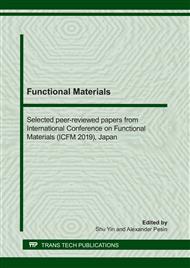p.45
p.51
p.59
p.65
p.73
p.81
p.87
p.95
p.103
Study on Reuse of Wasted Diatomite from Brewing Industry for Building Materials
Abstract:
In order to solve environmental problems and reduce the cost of building materials, this study used waste diatomite from brewing industry to develop novel cement mortar and compared it with pristine one. After pretreatment with water, soaking, drying, it is shown in the microscope that the treated diatomite has recovered its porosity. The thermogravimetric analysis also showed that the purity of treated diatomite was greater than 93%, confirming that most of the originally adsorbed organic matter was removed. Further, the diatomite after the treatment was used to prepare a novel cement mortar, and it was found that the optimum compressive strength was obtained when the water-cement ratio was 0.65 and the amount of diatomite added was 20%. It was found that the average compressive strength after 28 days was 284.03 kg/cm2, which was 81.22 kg/cm2 higher than that of the pristine cement mortar. It is proved that the addition of diatomite can increase the strength of the cement mortar and effectively reuse the waste diatomite.
Info:
Periodical:
Pages:
73-78
Citation:
Online since:
May 2020
Keywords:
Price:
Сopyright:
© 2020 Trans Tech Publications Ltd. All Rights Reserved
Share:
Citation:


